North Foreland
North Foreland[1] is a chalk headland on the Kent coast of southeast England.
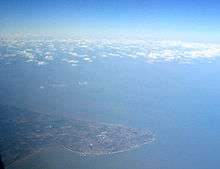
North Foreland forms the eastern end of the Isle of Thanet. It presents a bold cliff to the sea, and commands views over the southern North Sea.
Lighthouse
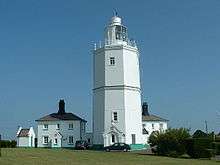 North Foreland Lighthouse | |
 Kent | |
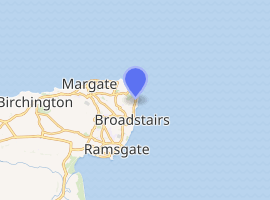
| |
| Location | Kent, United Kingdom |
|---|---|
| Coordinates | 51.37490°N 1.44510°E |
| Year first constructed | 1636 (first) |
| Year first lit | 1691 (current) |
| Automated | 1998 |
| Construction | stone tower |
| Tower shape | octagonal tower with balcony and lantern attaches to a 2-storey keeper's house |
| Markings / pattern | white tower and lantern |
| Tower height | 26 m (85 ft) |
| Focal height | 57 m (187 ft) |
| Current lens | 1st order catadioptric fixed lens |
| Light source | 4x 230 V 500 W halogen lamps |
| Intensity | 60,800 candela |
| Range | 19 nmi (35 km; 22 mi) |
| Characteristic | Fl (5) RW 20s. |
| Admiralty number | A0966 |
| NGA number | 1364 |
| ARLHS number | ENG-087 |
| Managing agent | Trinity House[2] [3] |
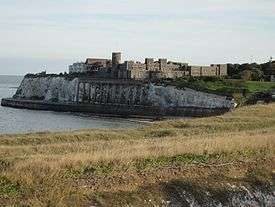
Early history
There was probably some sort of a beacon at an earlier period but the first distinct intimation concerning a lighthouse on the North Foreland is in the year 1636 when Charles I by letters-patent granted to Sir John Meldrum licence to continue and renew the lighthouses erected on the North and South Forelands.[4]
It seems that the lighthouse erected by Sir John consisted merely of a house built with timber lath and plaster on the top of which a light was kept in a large glass lantern for the purpose of directing ships in their course. This house was burnt down by accident in the year 1683 after which for some years use was made of a sort of beacon on which a light was hoisted. But near the end of the same century a strong octagonal structure of flint was erected on the top of which was an iron grate quite open to the air in which a good fire of coals was kept blazing at night.[4] In 1719 ownership of both the North and South Foreland lights passed by will to the Trustees of Greenwich Hospital.[5]
18th century
_cropped_(N_Foreland_Lighthouse).jpg)
About the year 1732 the top of this lighthouse was covered with a sort of lantern with large sash windows and the fire was kept bright by bellows with which the attendants blew throughout the night. This contrivance is said to have been for the purpose of saving coals but it would seem more probable that it was in order to preserve the fire from being extinguished by rain. However the plan did not work well and great injury resulted to navigation as many vessels were lost on the sands from not seeing the light and so little was it visible at sea that mariners asserted that they had often in hazy weather seen the Foreland before they could discover the light. They added that before the lantern was placed there and when the fire was kept in the open air the wind kept the fire in a constant blaze which was seen in the air far above the lighthouse. Complaints of this sort were so loud and frequent that the governors of Greenwich Hospital sent Sir John Thomson to examine and make arrangements on the subject. He ordered the lantern to be taken away and things to be restored to nearly their former state the light to continue burning all the night until daylight.[4]
Towards the end of the 18th century the North Foreland Lighthouse underwent some considerable alterations and repairs. In 1792, under the supervision of John Yenn (Surveyor to Greenwich Hospital), two stories of brick were built on the original structure which raised it to the height of 100 feet including the lantern room at the top in which the lights were kept. (To prevent accidents from fire the lantern room was coated with copper as was also the gallery around it; this gallery used to be much frequented by the visitors to Margate on account of the extensive views.)[4] At the same time oil lamps were installed in the tower, together with a new optical system designed by Thomas Rogers (who had previously installed a similar system in the lower lighthouse at Portland): it consisted of two rows of nine lamps and reflectors arranged in a convex curve,[6] placed behind a row of solid glass convex lenses which were incorporated within the glazing around the lantern room.[5]
19th century
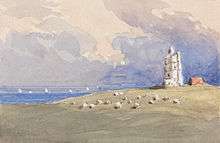
In 1832 Trinity House purchased the North and South Foreland lighthouses from Greenwich Hospital and two years later the lenses were removed. In 1860 under the supervision of engineer Henry Norris a new multi-wick oil burner was installed together with a large (first-order) fixed catadioptric optic manufactured by Sautter & Co. of Paris, replacing the previous catoptric apparatus of 18 Argand lamps & reflectors.[7] At the same time the two keepers cottages added. These works coincided with the successful experiments carried out in 1857–60 at the South Foreland lighthouse by Professor Frederick Hale Holmes with an alternating current electric arc light[8] which were the subject of a lecture by Michael Faraday at the Royal Institution[9] and paved the way for the construction a decade later of the world's first lighthouse designed for such a light, Souter Lighthouse.
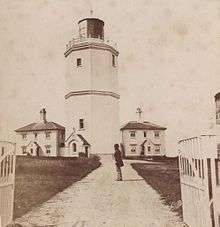
In June 1860 a red sector was added to the light, which shone northwards 'to enable vessels at night to keep to the eastward of Margate Sand'.[10] In 1880 the light characteristic was changed from fixed to occulting (being eclipsed for five seconds every half minute);[11] In 1884 the lighthouse was restored and improved:[12] the interior of the tower (which had previously contained rooms on several storeys) was completely gutted and an inner circular brick wall was constructed, which supported a new cantilevered stone staircase leading from ground level to the service room, immediately below the lantern.[13] In 1890 a new lantern room was added.[14]
20th century
An improved incandescent oil lamp was installed in the tower in 1905. When the lamp was electrified in 1930 it was given its current flashing characteristic.[5]
During the Second World War a number of radar stations were set up by German forces in France and the Netherlands to detect allied aircraft flying across the English Channel and a chain of top secret radar jamming stations were set up by British scientists along the south east coast of Britain. An array of transmitters was set out around the gallery of the lighthouse controlled by equipment in the lower lantern as part of this chain.[15]
North Foreland lighthouse was the last manned lighthouse in the UK but was automated in a ceremony presided over by the Duke of Edinburgh in 1998.[16] Dermot Cronin and Tony Homewood were the last Principal Lighthouse Keepers that manned North Foreland lighthouse.[17]
Present day
The lighthouse remains operational and is monitored and controlled by Trinity House from its Planning Centre at Harwich. The 1860 optic is still in use with a modern light source displaying a group-flashing characteristic.
A painting of the lighthouse by Elwin Hawthorne is in the Russell-Cotes Art Gallery & Museum.[18]
Currently, the cottages around the lighthouse can be rented as holiday accommodation.
Battles
Two naval battles of the Anglo-Dutch Wars are called the Battle of the North Foreland after the cape:
- The Battle of the Gabbard, 2–3 June 1653, in the First Anglo-Dutch War.
- The St. James's Day Battle, 25–26 July 1666, in the Second Anglo-Dutch War.
Radio station
A coastal radio station was established adjacent to the light house in 1901. Its call sign was 'GNF'. The transmitting function was later moved about a mile inland, although the medium wave receiving aerial remained operational until closure in 1991.[19]
References
- TR 39860 69616 51°22′30″N 1°26′42″E
- North Foreland The Lighthouse Directory. University of North Carolina at Chapel Hill. Retrieved 3 May 2016
- North Foreland Lighthouse Trinity House. Retrieved 3 May 2016
- "The Penny Magazine of the Society for the Diffusion of Useful Knowledge". Charles Knight. 19 April 2018. Retrieved 19 April 2018 – via Google Books.
- Woodman, Richard; Wilson, Jane (2002). The Lighthouses of Trinity House. Bradford-on-Avon, Wilts.: Thomas Reed. pp. 114–118.
- "Lighthouse management : the report of the Royal Commissioners on Lights, Buoys, and Beacons, 1861, examined and refuted Vol. 1". p. 33.
- "Lighthouse management : the report of the Royal Commissioners on Lights, Buoys, and Beacons, 1861, examined and refuted Vol. 2". p. 79.
- "Lighthouse Illumination by Magneto-Electricity". The Dublin Builder. 15 August 1864. p. 14.
an agreement was made for a trial at the South Foreland, but it was not till the of December that this experiment at an actual lighthouse was commenced... M. Reynaud, the Director-General of the French Lighthouses, inspected the light on April 20, 1859; it was visited by most of the members of the Royal Commission of Lights, Buoys, and Beacons, including myself, three days afterwards, and on the same day Professor Faraday wrote a report to the Trinity House. The opinions expressed were so far favourable that the Elder Brethren desired a further trial of six months, during which time the light was to be entirely under their own control, Mr. Holmes not being allowed interfere in any way. The light was again kindled on August 22
- "Newcastle Courant". 30 March 1860. p. 3.
MAGNETO-ELECTRIC LIGHT FOR LIGHTHOUSES – Professor Faraday, in a lecture delivered at the Royal Institution, says: "By means of a magnet, and of motion, we can get the some kind of electricity as from the battery; and, under the authority of the Trinity House, Professor Holmes has been occupied in introducing the magneto-electric light in the lighthouse at the North Foreland...For the last six months the North Foreland has been shining by means of this electric light beyond all comparison better than its former light. Never for once during six months has it failed in doing its duty
- London Gazette, Issue 22401, Page 2544, 6 July 1860
- London Gazette, Issue 24871, Page 4322, 6 August 1880
- Davenport Adams, W. H. (1891). The Story of our Lighthouses and Lightships: Descriptive and Historical (PDF). London, Edinburgh & New York: Thomas Nelson & Sons. pp. 132–133. Retrieved 27 February 2019.
- Colston, Belinda; Fielding, Nicole; Blakeley, Ron (Winter 2013). "north Foreland Conservation". Flash (20): 6. Retrieved 21 March 2019.
- "North Foreland Lighthouse". Trinity House. Retrieved 21 March 2019.
- Douglas-Sherwood, Gerry (2004). "Radar Jamming at North Foreland Lighthouse" (PDF). World Lighthouse Society Newsletter. World Lighthouse Society. 2 (2): 13. Archived from the original (PDF) on 5 February 2006. Retrieved 16 March 2012.
- Anon (26 November 1998). "Lights out for the last keepers". BBC News UK. BBC. Retrieved 16 March 2012.
- "Light goes out on maritime history". The Independent. 26 October 1998. Retrieved 19 April 2018.
- "North Foreland Lighthouse, Broadstairs, Kent". Art UK. Retrieved 29 November 2015.
- "Northforeland Radio Callsign "GNF"". Retrieved 6 January 2019.
External links
| Wikimedia Commons has media related to North Foreland Lighthouse. |